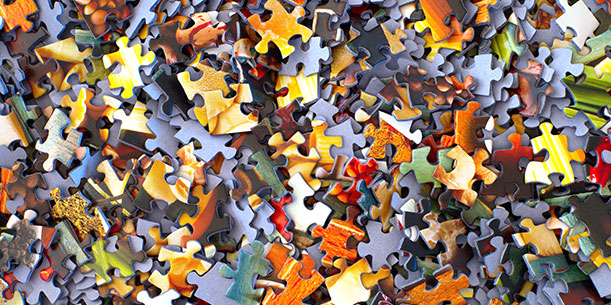BOOMbox at Home: Puzzles
May 26, 2021

In the coming weeks, the BOOMbox at Home will explore different types of games. This week we’re exploring all different types of puzzles and their history, from the classics like jigsaw and crosswords, to more complex logic and riddles. We’ll also cover how to make your own DIY puzzles from materials you may have lying around the house.
History of Puzzles
Have you ever wondered when the first puzzle was created? They have actually been around since the beginning of time when humans began to look at the world around them in more complex ways.
Some of the earliest forms of puzzles were tactile puzzles, with the first one coming from the Indus Valley civilization in 2250 BCE. Similar ones were later seen in ancient China and Rome as well. Lots of puzzles were initially used to hide valuables in secret compartments, so that only the true owner could solve it and gain access to whatever was inside.
Jigsaw puzzles date back to the 1760s, when European mapmakers pasted maps onto wood and cut them into small pieces. John Spilsbury, an engraver and mapmaker, is credited with inventing the first jigsaw puzzle in 1767. This dissected map has been a successful educational toy ever since, with many children still using it to learn geography today. Puzzles became a form of entertainment in the 1900s and became even more popular with the onset of the Great Depression in 1929, and a bit earlier with the invention of crosswords in 1913, for which sales reached an astounding 10 million per week. Puzzles were a way for people to escape from troubled times, and it gave them an opportunity to feel a sense of accomplishment as well. Today, lots of adults and kids love trying puzzles to challenge themselves and do something new.
If you want to learn more about the history of puzzles, see these resources:
- Chronological History of Puzzles
- Brief History of Puzzles from the Puzzle Museum
- History of Crossword Puzzles
Online Puzzles
There are thousands of puzzles out there, but it can be hard finding some really good ones. If you want to explore some online puzzles, try Digipuzzle, which offers dozens of options, from jigsaw and sudoku to spot-the-difference games. If you prefer doing physical puzzles on paper instead of on a computer, see Puzzles to Print. That website offers hundreds of different puzzles, all categorized by type. If you like themed crossword puzzles, you’ll be able to find topics like animals, fruits, or even sports! If you like math, try the magic squares puzzle, which is a great way to practice addition and subtraction.
For more puzzle fun, check out these resources:
DIY String and Bead Puzzle
What better way to learn about puzzles than to actually make one yourself. This string-and-bead puzzle is easy to make and super fun to solve.
You will need some thick string or yarn, a bead, scissors, a ruler, a hole puncher, and cardboard (from something like a cereal box). Follow these instructions:
- Cut the cardboard into a narrow strip, about 9 inches by 2 inches.
- Punch three holes into the strip of cardboard an equal distance apart.
- Cut some string about 30 inches long. Fold the string in half and push the loop through the center hole.
- Slip ends through the loop and pull it closed.
- Thread the bead on one end of the string.
- Thread the ends of the string through the end holes and knot on the back of the cardboard.
Now you’ve completed making the puzzle! The goal is to try to get the bead from one end of the string to the other. If you get stuck, here are some hints: make sure to pull the loop forward, pull all four strands through the center hole, and follow the string with the bead.
For detailed instructions on how to make the puzzle and pictures to guide you, see these resources:
Scientist of the Week
What’s a 12-letter word for the study of puzzles? If you guessed enigmatology, you’re right! Will Shortz is the world’s one and only academically accredited puzzle master. He designed his own major program at Indiana University, which in 1974 led to his one-of-a-kind degree in Enigmatology, the study of puzzles.
According to Will’s biography, he has been the puzzle master for NPR's “Weekend Edition Sunday” since the program's start in 1987, crossword editor of The New York Times since 1993, editor of Games magazine for 15 years, and the founder and director of the American Crossword Puzzle Tournament, which has been held annually since 1978. He also founded the World Puzzle Championship in 1992, and he cofounded the World Puzzle Federation in 1999. Will also happens to own the world's largest puzzle library, numbering more than 25,000 puzzle books and magazines dating back to 1533. Today, he mostly spends his time creating crosswords for The New York Times and traveling around the world to tell people about his love for puzzles.
Share
We’d love to hear about how your DIY puzzles turned out. Tag @skokielibrary when you share photos of what you’ve created on social media.
Written by Mahnoor.